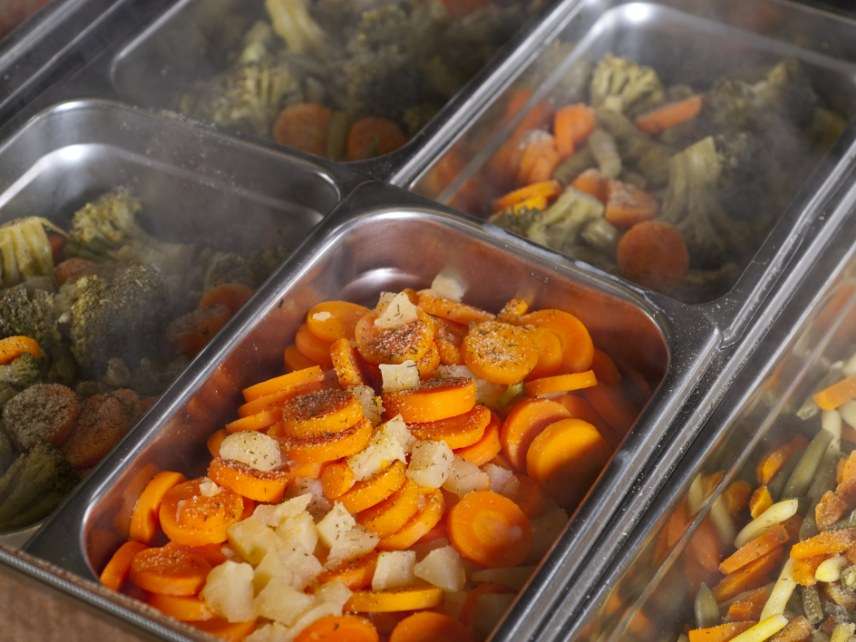States Fight Back Against USDA Rules That Cause School Food Waste
Bad mandates result in uneaten foods. Schools figure out how to respond.

The mountains of food waste that the U.S. Department of Agriculture's (USDA) National School Lunch Program causes are again making headlines around the country. Many of these stories show states and local school systems are frantic to figure out ways to address the program's wastefulness.
Food waste and the school lunch program are intimately linked. While former First Lady Michelle Obama—and her campaign to make school food healthier—is not responsible for creating the problem of food waste in our nation's schools, the law she championed, the Healthy, Hunger-Free Kids Act, has made an already bad problem far worse.
"That directive is costing schools an added $5.4 million a day, of which $3.8 million worth of produce goes directly into the trash, according to national estimates," reads one recent editorial in a Connecticut paper chastising the USDA for all of the food waste its program creates. "A Harvard Public Health study found that 60 percent of the vegetables and 40 percent of the fruits are being tossed. Researchers at the University of Vermont found an overall increase of 56 percent in wasted food as a direct result of the mandate."
The current administration announced last spring that it would roll back some of the Obama administration's rules.
"If kids aren't eating the food, and it's ending up in the trash, they aren't getting any nutrition—thus undermining the intent of the program," said USDA Secretary Sonny Perdue in May.
Perdue's got all his facts right. But he's not telling even half the story.
"Since the reforms have taken hold, there's been a notable downward shift in the rates of students eating school lunches," I write in my book, Biting the Hands that Feed Us: How Fewer, Smarter Laws Would Make Our Food System More Sustainable—in a lengthy chapter on the government's role in promoting food waste. "Students are voting with their mouths. According to federal government data, the USDA School Lunch Program served 258 million fewer lunches in 2014 than it did at its high point, in 2010. The number of students paying full price for school lunches today—now 8.8 million— is at its lowest point in recorded history. That's a drop of more than 50 percent in full-price lunch sales since 1970."
While the numbers continue to plummet and the waste piles up, states, counties, and individual school systems are implementing a variety of approaches to combat the latter issue.
In California, a new law will allow schools to donate uneaten food to charities in the state. "Under the new law, public schools can give their unopened packaged food, unopened milk cartons (kept cold) and uncut produce, like apples, to food banks and other charities," reports the L.A. Daily News. The law doesn't take effect until January.
The author of the California law, State Sen. Ed Hernandez (D), says he was inspired to introduce the legislation in part because the Los Angeles school system alone was "throwing away $100,000 worth of food a day." That translates to 600 tons of food being wasted by one school system each day.
Texas adopted a similar law that's already taken effect. Under that new state law, schools can "create food pantries on campus where they can store donated food as well as surplus food from the cafeteria." The schools can then redistribute the food to nonprofits that feed people in need.
Other states have implemented "share tables." (As a young kid, I always brought my lunch to school but also scoured my elementary school's share table for uneaten coleslaw, fruit salad, and peanut butter & Fluff sandwiches.)
Many individual schools are trying to reduce their food waste as best they can. In Vermont, some schools are composting school-lunch waste. At one Connecticut school, students may place unopened foods that would go to waste into a small refrigerator. Students are also free to take food from the same fridge. Any uneaten food is donated to a food bank. And in Alaska, a 300-lb. moose carcass, recently roadkill that might otherwise have gone to waste, made its way to the school lunch menu thanks to enterprising community members and the diligent work of "the students of Mrs. Boron's American Government class," who deboned the carcass in preparation for cooking.
Some school systems have opted out of the USDA program altogether. That's a start—as I've discussed in previous columns, including this one, and expand upon in my book. But that's only part of the solution.
States and schools alike can be commended for combating food waste in schools. But as long as the USDA spends billions on school-lunch policies that promote food waste, those states and school systems—along with opponents of food waste—are fighting a losing battle.


Show Comments (31)